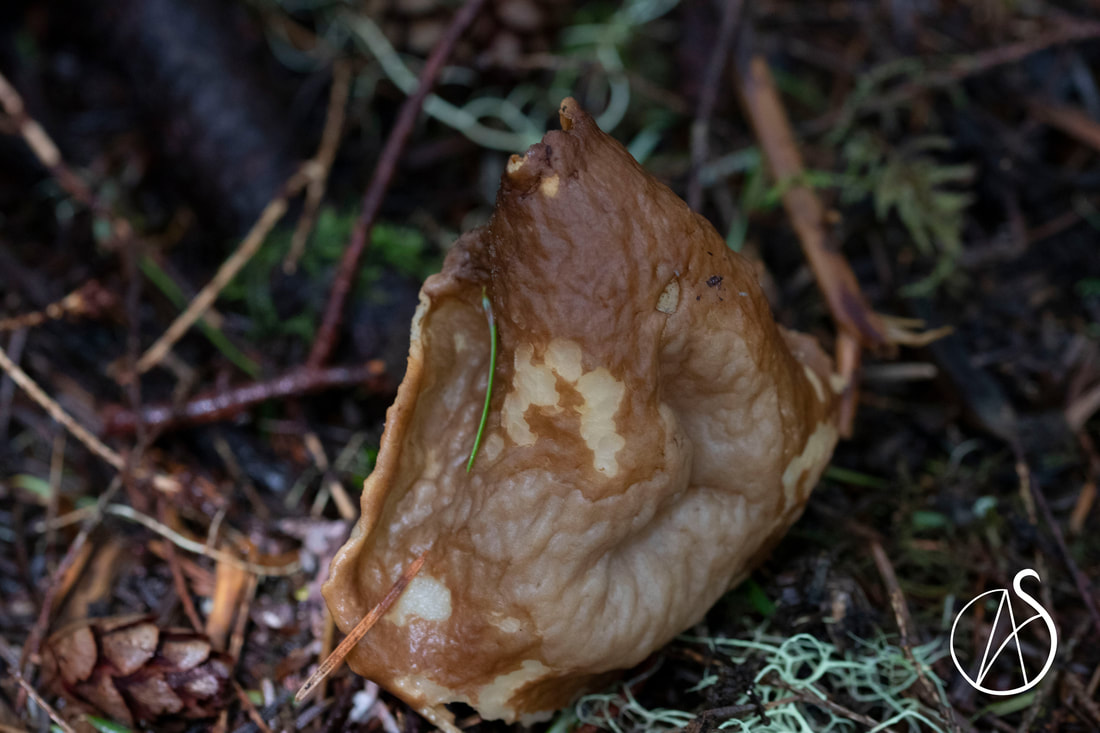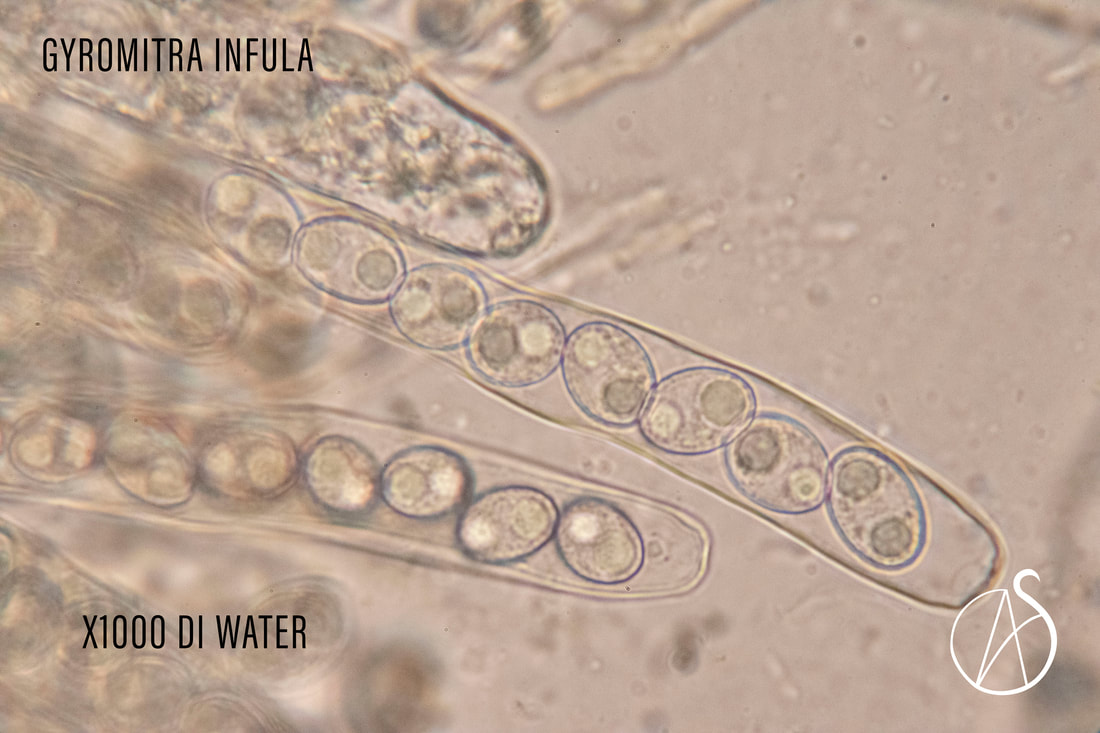Gyromitra esculenta
If you have ever been out in the forest during the springtime in the Pacific Northwest, you have probably come across one of these brain-looking mushrooms - Gyromitra esculenta. These red pitted, folded, and lobed heads on these mushrooms sit on top of fleshy colored stems and are often mistaken for Morels, to the untrained eye. This is one of those occasions where you should be extra careful with these mushrooms because they are very toxic raw.
The Gyromitra esculenta belongs to a division of fungi known as Ascomycetes. There are two main divisions in the Fungi kingdom, Ascomycete and Basidiomycete. My favorite mushrooms to study are the Ascomycetes because of their unusual forms. Asco's (as we refer to them) show up in such forms as fluted, cups, brain-like, spheres and other unusual shapes. They are also the fungus part that make up the complex bodies of lichen. Some of the more famous Ascomycetes that you may have heard of are Morels! And some of the largest Ascomycete specimens ever found have been in the Gyromitra family of mushrooms.
 Gyromitra esculenta found on April 15, 2020.
Gyromitra esculenta found on April 15, 2020.
This mushroom is poisonous!
All of the Gyromitra and Morchella genera contain the toxin gyromitrin (chemical formula C4H8N2O, and its chemical name is N’-ethylidene-N-methylformohydrazide), or Monomethylhydrazine (MMH), that is a volatile compound used in the production of rocket fuel and was used by NASA in the Titan Rockets. Gyromitrin has a low boiling point of 190 F, and is a dangerous carcinogen that affects the Central Nervous System (CNS), liver and kidney function. “Monomethylhydrazine binds to and inhibits pyridoxal phosphokinase, thereby inhibiting activation of vitamin B6 (as pyridoxal 5-phosphate) from functioning as the key co-factor in the synthesis of GABA. The subsequent depletion of GABA leads to CNS excitation and seizures.”[Source] Our bodies, or the cooking process essentially take the gyomitrin toxin and hydrolyze it into the Monomethlhydrazine.
This is why it is it is so important to make sure to separate your collections from edible mushrooms. And NEVER eat a raw mushroom. These mushrooms can cause serious illness and even death if consumed raw.
This is why it is it is so important to make sure to separate your collections from edible mushrooms. And NEVER eat a raw mushroom. These mushrooms can cause serious illness and even death if consumed raw.
Microscopically, Ascomycetes are some of my favorite things to look at. If you are interested in learning more about what you are looking at here in these microscopy photos, check out this post. In the following photos you can see the Asci holding 8 spores. These spores help separate and identify those tricky look-a-like mushrooms. Sometimes it is hard to tell a Gyromitra from a Morchella or Helvella specimen, and these spores help do it. If you look closely you can see a set of spores - they are an ellipse shape with two little darker circles at each end of the spore. To me, they kind of look like little E.T. or Hey Arnold! heads. This shape is called broadly elliptical, and those little spots are called guttules. The Gyromitra esculenta has two guttules (known as biguttulate) at each end of the spore. In a Helvella maculata, there is only one large guttule in the spore and it is almost as big as the spore!
Additionally, you can see the paraphyses, those long thin tubes behind the large ones, and those also help to identify the mushroom. These paraphyses are cylindrical and branched with clavate tips.
Additionally, you can see the paraphyses, those long thin tubes behind the large ones, and those also help to identify the mushroom. These paraphyses are cylindrical and branched with clavate tips.
Gyromitra esculenta
Classification:
Fungi
Ascomycota
Pezizomycetes
Pezizales
Discinaceae
Gyromitra
Description:
Cap (head): 3.5-10 cm wide, 4-10 cm tall, brain-like, it is dark brownish red to pinkish tan, and dry, the margin is inrolled.
Stalk: 2-7 cm tall and 2-3 cm thick, it is dingy white to pinkish tan and stuffed with a cottony hyphae.
Spores: 28x13 um, elliptic, smooth, biguttule, unisterate, hyline
Asci: 350x20 um, 8 spores per asci
Paraphyses: cylindrical, branched with clavate tips
Found scattered in groups on the ground under conifers.
Appear in spring and early summer.
Classification:
Fungi
Ascomycota
Pezizomycetes
Pezizales
Discinaceae
Gyromitra
Description:
Cap (head): 3.5-10 cm wide, 4-10 cm tall, brain-like, it is dark brownish red to pinkish tan, and dry, the margin is inrolled.
Stalk: 2-7 cm tall and 2-3 cm thick, it is dingy white to pinkish tan and stuffed with a cottony hyphae.
Spores: 28x13 um, elliptic, smooth, biguttule, unisterate, hyline
Asci: 350x20 um, 8 spores per asci
Paraphyses: cylindrical, branched with clavate tips
Found scattered in groups on the ground under conifers.
Appear in spring and early summer.
For comparison, this mushroom, Gyromitra infula, also grows around the same time as the Gyromitra esculenta. This mushroom is in the same family of mushrooms, the Discinaceae family, and also contains broadly elliptical, biguttulate spores. This saddle shaped cap is not quite as brain-like as the G. esculenta, and it has more of a flat shape and very little stem. I found both of these species fruiting at the same time within 100 feet from each other.
Resources:
https://www.mycobank.org/page/Simple%20names%20search
[1] https://www.ncbi.nlm.nih.gov/books/NBK470580/?report=printable
Arora, David (1986). Mushrooms Demystified, 2nd ed.
Beug, Michael W., Alan E. Bessette, & Arleen R. Bessette. (2014). Ascomycete Fungi of North America: A Mushroom Reference Guide. University of Texas Press, Austin, Texas.
Beug, Michael W. (2014). False Morels- Age-old Questions of Edibility: a primer by Michael Beug. FUNGI, Volumne 7:1, p. 28-31, https://www.fungimag.com/spring-2014-articles-02/V7I1%20LR%20FalseMorels28-31pdf.pdf?fbclid=IwAR1hM17324X2ZFk4lShYf3Wms39WNOWe_Ot46vXTautAV8b5waTf-PIVm2o
Largent, David & David Johnson. How to Identify Mushrooms to Genus III: Microscopic Features
Hansen, K., et al. “Pindara Revisited – Evolution and Generic Limits in Helvellaceae.” Persoonia - Molecular Phylogeny and Evolution of Fungi, vol. 42, no. 1, 2019, pp. 186–204., doi:10.3767/persoonia.2019.42.07. (LINK)
Horowitz KM, Horowitz BZ. Gyromitra Mushroom Toxicity. [Updated 2019 Dec 20]. In: StatPearls [Internet]. Treasure Island (FL): StatPearls Publishing; 2020 Jan-. Available from: https://www.ncbi.nlm.nih.gov/books/NBK470580/
HUHTINEN, S. & RUOTSALAINEN, J. 2004: Notes on the taxonomy and occur- rence of some species of Gyromitra in Finland. - Karstenia 44: 25-34, 2004. Helsinki. ISSN 0453-3402.
Keahi M. HorowitzB Z. Horowitz
Horowitz, Keahi M., & BZ. Horowitz. (2019). Gyromitra Mushroom Toxicity. StatPearls Publishing; Treasure Island (FL). A service of the National Library of Medicine, National Institutes of Health. https://www.ncbi.nlm.nih.gov/books/NBK470580/?report=printable
Missouri Department of Conservation https://nature.mdc.mo.gov/discover-nature/field-guide/false-morels
Medel, Rosario and Jose Marmolejo. (2005). Micromorofolgia de esporas en algunas especies de Gyromitra s.l. (Ascomycotina, Pezizales, Discinaceae), Revista Mezicana de Micologia, 21, p 15-21. https://www.academia.edu/20271724/Spore_micromorphology_of_some_Gyromitra_s._l._species_Ascomycotina_Pezizales_Discinaceae_
McKnight, Kent H. (1971) "On two species of false morels (Gyromitra) in Utah," Great Basin Naturalist: Vol. 31 : No. 2 , Article 1. Available at: https://scholarsarchive.byu.edu/gbn/vol31/iss2/1
NAMA https://namyco.org/mushroom_poisoning_syndromes.php#gyro
Siegel, Noah and Christian Schwarz (2016). Mushrooms of the Redwood Coast: A Comprehensive Guide to Fungi of Coastal Northern California
Trudell, Steve & Joe Ammirati (2009). Mushrooms of the Pacific Northwest
Bergo, Alan, Forager Chef. (2017) On cooking false morels/Gyromitra.
https://foragerchef.com/on-cooking-false-morels-gyromitra/
My iNaturalist observations:
https://www.inaturalist.org/observations/43510212
https://www.inaturalist.org/observations/42377497
https://www.inaturalist.org/observations/47180978
https://www.mycobank.org/page/Simple%20names%20search
[1] https://www.ncbi.nlm.nih.gov/books/NBK470580/?report=printable
Arora, David (1986). Mushrooms Demystified, 2nd ed.
Beug, Michael W., Alan E. Bessette, & Arleen R. Bessette. (2014). Ascomycete Fungi of North America: A Mushroom Reference Guide. University of Texas Press, Austin, Texas.
Beug, Michael W. (2014). False Morels- Age-old Questions of Edibility: a primer by Michael Beug. FUNGI, Volumne 7:1, p. 28-31, https://www.fungimag.com/spring-2014-articles-02/V7I1%20LR%20FalseMorels28-31pdf.pdf?fbclid=IwAR1hM17324X2ZFk4lShYf3Wms39WNOWe_Ot46vXTautAV8b5waTf-PIVm2o
Largent, David & David Johnson. How to Identify Mushrooms to Genus III: Microscopic Features
Hansen, K., et al. “Pindara Revisited – Evolution and Generic Limits in Helvellaceae.” Persoonia - Molecular Phylogeny and Evolution of Fungi, vol. 42, no. 1, 2019, pp. 186–204., doi:10.3767/persoonia.2019.42.07. (LINK)
Horowitz KM, Horowitz BZ. Gyromitra Mushroom Toxicity. [Updated 2019 Dec 20]. In: StatPearls [Internet]. Treasure Island (FL): StatPearls Publishing; 2020 Jan-. Available from: https://www.ncbi.nlm.nih.gov/books/NBK470580/
HUHTINEN, S. & RUOTSALAINEN, J. 2004: Notes on the taxonomy and occur- rence of some species of Gyromitra in Finland. - Karstenia 44: 25-34, 2004. Helsinki. ISSN 0453-3402.
Keahi M. HorowitzB Z. Horowitz
Horowitz, Keahi M., & BZ. Horowitz. (2019). Gyromitra Mushroom Toxicity. StatPearls Publishing; Treasure Island (FL). A service of the National Library of Medicine, National Institutes of Health. https://www.ncbi.nlm.nih.gov/books/NBK470580/?report=printable
Missouri Department of Conservation https://nature.mdc.mo.gov/discover-nature/field-guide/false-morels
Medel, Rosario and Jose Marmolejo. (2005). Micromorofolgia de esporas en algunas especies de Gyromitra s.l. (Ascomycotina, Pezizales, Discinaceae), Revista Mezicana de Micologia, 21, p 15-21. https://www.academia.edu/20271724/Spore_micromorphology_of_some_Gyromitra_s._l._species_Ascomycotina_Pezizales_Discinaceae_
McKnight, Kent H. (1971) "On two species of false morels (Gyromitra) in Utah," Great Basin Naturalist: Vol. 31 : No. 2 , Article 1. Available at: https://scholarsarchive.byu.edu/gbn/vol31/iss2/1
NAMA https://namyco.org/mushroom_poisoning_syndromes.php#gyro
Siegel, Noah and Christian Schwarz (2016). Mushrooms of the Redwood Coast: A Comprehensive Guide to Fungi of Coastal Northern California
Trudell, Steve & Joe Ammirati (2009). Mushrooms of the Pacific Northwest
Bergo, Alan, Forager Chef. (2017) On cooking false morels/Gyromitra.
https://foragerchef.com/on-cooking-false-morels-gyromitra/
My iNaturalist observations:
https://www.inaturalist.org/observations/43510212
https://www.inaturalist.org/observations/42377497
https://www.inaturalist.org/observations/47180978
















